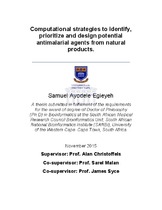| dc.description.abstract | Introduction: There is an exigent need to develop novel antimalarial drugs in view of the mounting disease burden and emergent resistance to the presently used drugs against the malarial parasites. A large amount of natural products, especially those used in ethnomedicine for malaria, have shown varying in-vitro antiplasmodial activities. Facilitating antimalarial drug development from this wealth of natural products is an imperative and laudable mission to pursue. However, the limited resources, high cost, low prospect and the high cost of failure during preclinical and clinical studies might militate against pursue of this mission. Chemoinformatics techniques can simulate and predict essential molecular properties required to characterize compounds thus eliminating the cost of equipment and reagents to conduct essential preclinical studies, especially on compounds that may fail during drug development. Therefore, applying chemoinformatics techniques on natural products with in-vitro antiplasmodial activities may facilitate identification and prioritization of these natural products with potential for novel mechanism of action, desirable pharmacokinetics and high likelihood for development into antimalarial drugs. In addition, unique structural features mined from these natural products may be templates to design new potential antimalarial compounds. Method: Four chemoinformatics techniques were applied on a collection of selected natural products with in-vitro antiplasmodial activity (NAA) and currently registered antimalarial drugs (CRAD): molecular property profiling, molecular scaffold analysis, machine learning and design of a virtual compound library. Molecular property profiling included computation of key molecular descriptors, physicochemical properties, molecular similarity analysis, estimation of drug-likeness, in-silico pharmacokinetic profiling and exploration of structure-activity landscape. Analysis of variance was used to assess statistical significant differences in these parameters between NAA and CRAD. Next, molecular scaffold exploration and diversity analyses were performed on three datasets (NAA, CRAD and malarial data from Medicines for Malarial Ventures (MMV)) using scaffold counts and cumulative scaffold frequency plots. Scaffolds from the NAA were compared to those from CRAD and MMV. A Scaffold Tree was also generated for all the datasets. Thirdly, machine learning approaches were used to build four regression and four classifier models from bioactivity data of NAA using molecular descriptors and molecular fingerprints. Models were built and refined by leave-one-out cross-validation and evaluated with an independent test dataset. Applicability domain (AD), which defines the limit of reliable predictability by the models, was estimated from the training dataset and validated with the test dataset. Possible chemical features associated with reported antimalarial activities of the compounds were also extracted. Lastly, virtual compound libraries were generated with the unique molecular scaffolds identified from the NAA. The virtual compounds generated were characterized by evaluating selected molecular descriptors, toxicity profile, structural diversity from CRAD and prediction of antiplasmodial activity. Results: From the molecular property profiling, a total of 1040 natural products were selected and a total of 13 molecular descriptors were analyzed. Significant differences were observed between the natural products with in-vitro antiplasmodial activities (NAA) and currently registered antimalarial drugs (CRAD) for at least 11 of the molecular descriptors. Molecular similarity and chemical space analysis identified NAA that were structurally diverse from CRAD. Over 50% of NAA with desirable drug-like properties were identified. However, nearly 70% of NAA were identified as potentially "promiscuous" compounds. Structure-activity landscape analysis highlighted compound pairs that formed "activity cliffs". In all, prioritization strategies for the natural products with in-vitro antiplasmodial activities were proposed. The scaffold exploration and analysis results revealed that CRAD exhibited greater scaffold diversity, followed by NAA and MMV respectively. Unique scaffolds that were not contained in any other compounds in the CRAD datasets were identified in NAA. The Scaffold Tree showed the preponderance of ring systems in NAA and identified virtual scaffolds, which maybe potential bioactive compounds or elucidate the NAA possible synthetic routes. From the machine learning study, the regression and classifier models that were most suitable for NAA were identified as model tree M5P (correlation coefficient = 0.84) and Sequential Minimization Optimization (accuracy = 73.46%) respectively. The test dataset fitted into the applicability domain (AD) defined by the training dataset. The “amine” group was observed to be essential for antimalarial activity in both NAA and MMV dataset but hydroxyl and carbonyl groups may also be relevant in the NAA dataset. The results of the characterization of the virtual compound library showed significant difference (p value < 0.05) between the virtual compound library and currently registered antimalarial drugs in some molecular descriptors (molecular weight, log partition coefficient, hydrogen bond donors and acceptors, polar surface area, shape index, chiral centres, and synthetic feasibility). Tumorigenic and mutagenic substructures were not observed in a large proportion (> 90%) of the virtual compound library. The virtual compound libraries showed sufficient diversity in structures and majority were structurally diverse from currently registered antimalarial drugs. Finally, up to 70% of the virtual compounds were predicted as active antiplasmodial agents. Conclusions:Molecular property profiling of natural products with in-vitro antiplasmodial activities (NAA) and currently registered antimalarial drugs (CRAD) produced a wealth of information that may guide decisions and facilitate antimalarial drug development from natural products and led to a prioritized list of natural products with in-vitro antiplasmodial
activities. Molecular scaffold analysis identified unique scaffolds and virtual scaffolds from NAA that possess desirable drug-like properties, which make them ideal starting points for molecular antimalarial drug design. The machine learning study built, evaluated and identified amply accurate regression and classifier accurate models that were used for virtual screening of natural compound libraries to mine possible antimalarial compounds without the expense of bioactivity assays. Finally, a good amount of the virtual compounds generated were structurally diverse from currently registered antimalarial drugs and potentially active antiplasmodial agents. Filtering and optimization may lead to a collection of virtual compounds with unique chemotypes that may be synthesized and added to
screening deck against Plasmodium. | en_US |

